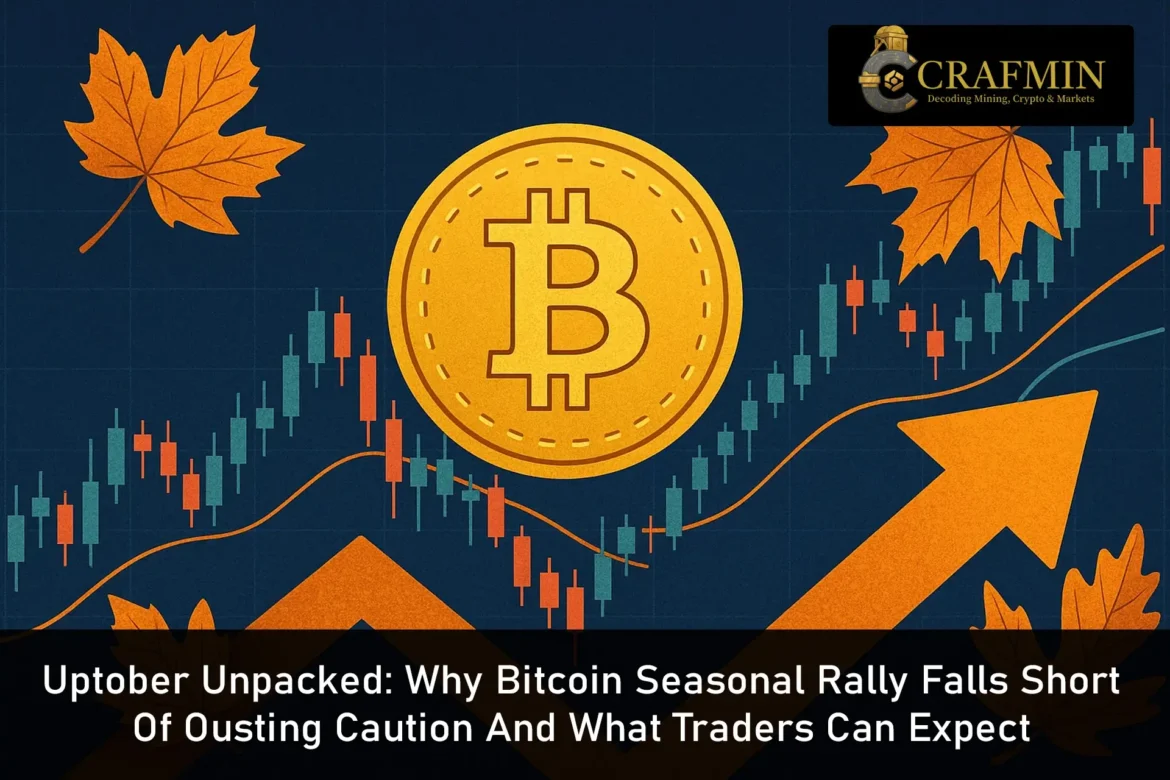Bitcoin rallies on markets, turning the calendar page over to historically robust months. “Uptober” is how market makers refer to it: October is seasonally a Bitcoin month that has traditionally been good, and there’s an even more powerful November. But there is a colossal flaw in the rally — profit disproportionately accrues to the largest coins, institutional money with gargantuan net outflows. The result: a price gain on its face that looks good but warrants examination of market health and resiliency. (CoinDesk)

Uptober lifts Bitcoin, but caution still lingers. (Image Source: Cointelegraph)
Why “Uptober” Remains Relevant Today
Seasonality is not make-believe, but a pattern. Those following Bitcoin returns from 2013 note that October has enormous mean gains, and November has long been used to maintain them. That calendar effect shows up in typically sleepy September as a period when momentum can pick up steam — a technical and psychological boost for year-end position trades. Seasonality impacts flows, sentiment risk, and headline narratives, which can seed self-sustaining price action. (CoinDesk)
The Very Shallow Bottom Of The Rally: A “Narrow” Snap-back
Through and including 29 September, the market records gains — but with starvation-thin depth. Rather than a broad mid- and small-cap altcoin bounce, there is merely strength in Bitcoin and some of the strongest large-cap altcoins. The smaller names see net selling. That’s important because rally gains spurred by participation are usually greater and longer-lasting; thinning rallies collapse overnight when a spark leaves or liquidity evaporates. Authorities cite this lack of correlation between lead price activity and market breadth as one of the largest warning signs. (Coinspeaker)

Bitcoin leads a thin rally, hinting at weak market breadth. (Image Source: XBO.com)
Institutional Flows Wag Tongues
Institutional participation generally lags price and credit-card-sized headlines. On Sept 26, US Bitcoin spot ETFs see a net one-day outflow of approximately US$418 million — the majority of the cake going to Fidelity’s FBTC and active redemptions of other top-of-mind funds such as BlackRock’s IBIT. Institutional size ETF redemptions do have an impact: They indicate institutional profiteers taking profit or rebalancing — even as they drive prices higher. Those that go off course can endanger price appreciation if retail powers the move under institutional conviction, equity lacks. (Phemex)
What The Figures Indicate (Brief, To The Point)
October has returned ~22% historically on average in Bitcoin; November has returned ~46% historically. Not a certainty — but it is a statistically strong trend which flips market sentiment around into Q4. (CoinDesk)
26 Sept spot ETF flows record ~US$418m of net redemptions with significant redemptions of Fidelity’s FBTC and dealer selling of BlackRock’s IBIT. Institutional flows trail or diverge from retail. (Phemex)
The Trader’s View: Position And Risk
Seasonality gives way to position-taking: algos and short calendar funds play; trend-chasing by retail traders, on-chain traders rotating between big-caps. But the shallow breadth and ETF outflow rewrite the risk rules. If institutional selling continues, it may peak out upside or turn the rally into a sucker’s rally for latecomers. Old timers are observing three things closely: breadth (who is in control), flows (who is building up), and liquidity (how fast one can cover).
Where Fantasy And Reality Meet — Three Real Scenarios
- Q4 seasonal bounce: Seasonality, macro optimism, and money market cash conflate. Institutions reverse prior redemptions, and weekly flows become neutral-to-positive. Breadth is stronger as capital rotates through the mid-cap alternatives. That setting drives prices up into the year-end. (CoinDesk)
- Squeezey short-term elevator: Shorts but institutional and momentum buying drive BTC and large alts. No buying at all, so one bearish catalyst (macro news headline, ETF redemptions, or derivatives liquidation) erases gains. (Phemex)
- Volatility with rotation: ETFs enjoy volatile flows with smart money rotating in and out of staking, into spot, and derivatives; some reduce risk, while others take carry. Winners and losers rotate in and out of stories and sectors as market choppes. (Bitcoin News)
Imagine seeing this set up on the monthly timeframe (the strongest timeframe signal indicator) + multiple confluences both TOTAL3 and BTC.D telling the same story, both on the MONTHLY, the fundamental confluences of M2 sky-rocketing, pro crypto regulation, ETFs coming for… https://t.co/IWPBcNhDDP
— CryptoGuerrilla ⚔️ (@Crypto_Guerrila) September 27, 2025
The Altcoin Story: Rotation And Leadership
Not all altcoins are equal. As market breadth decays, leadership narrows: a few liquidity- or narrative-sheltered projects soak up the buying while lesser tokens trail or are forced to sell. That is today’s reality: giant altcoins trading up while tail projects cannot get bids. For speculators and hedge funds, this translates into selective exposure — bet on off-chain drivers (partnerships, upgrades, token unlocks), on-chain signals rather than making vanilla bets. (Coinspeaker)
The Etf Paradox: Price Up, Flows Down
Prices are increasing while ETFs are draining losses. There are a variety of reasons that they can both occur:
- Timing mismatch: Spot markets front-running before official ETF flows are reported on a daily cadence.
- Profit-taking: Institutional rebalancing and fresh retail investors capturing the upside.
- Concentration of flows: Redemptions are concentrated in some products and swamp small inflows in the majority.
The takeaway: ETF outflows are not a short-term sell signal to prices, but a non-trivial alarm signal for where real money is. (Phemex)
Real-world Applicability: What Everyday Investors Should Watch Out For
If you are not an expert in the market, you should watch out for it because it impacts risk management:
- Seasonally-sourced tailwind makes profit likelihood — not certainty.
- Tightly integrates call for risk control restraint: use size limits, stop-losses, and don’t lever up in small illiquid tokens.
- Institutional redemptions remind us that headline price action can be fleeting — don’t confuse noise with trend.
This is not doom-mongering; this is a warning. Markets that are precariously balanced on thin stilts can move fast too — but at greater speed and with less warning. (CoinDesk)

Seasonal boosts aren’t guarantees — manage risk and don’t mistake noise for trends. (Image Source: HBS Online – Harvard Business School)
On-chain And Macro Metrics To Watch Out For Next
Keep an eye on this short list of metrics over the next days and weeks:
- ETF flow updates (daily): Are outflows switching or ongoing? Large single one-off redemptions are important. (Phemex)
- Market breadth: are small- and mid-cap altcoins leading the advance, or lagging? (Coinspeaker)
- Liquidations and derivatives open interest: over-leveraging can fuel up- and down-moves. (Aurpay)
- Macro headlines: interest-rate rumor, USD appreciation, or geo-politics can reverse sentiment overnight. (Investors)
Imagine seeing this set up on the monthly timeframe (the strongest timeframe signal indicator) + multiple confluences both TOTAL3 and BTC.D telling the same story, both on the MONTHLY, the fundamental confluences of M2 sky-rocketing, pro crypto regulation, ETFs coming for… https://t.co/IWPBcNhDDP
— CryptoGuerrilla ⚔️ (@Crypto_Guerrila) September 27, 2025
On-chain Data: Supply, Exchange Balances, And Whale Participants
Start with the supply. Long-term investors have coins in cold storage and exchanges with diminishing balances, the market tightens — fewer supplies to sell into rallies. Certain on-chain indicators point to exchange-held BTC multi-month lows, a solid fundamental bear position to make more money at higher prices if demand is such that the indicator explains a large way prices have some room for growth, even if institutional products indicate outflows. (CryptoDnes.bg)
But don’t confuse “supply tightening” with retail activity. On-chain settle volumes and transaction counts show who is reassigning coins. The recent weeks have witnessed fewer instances of small-sized transactions and rising mean transfer sizes — signals of larger players or institutions prefunding chain volumes ahead of the later arrival of the retail business. Such “concentration” leaves more latitude for dirty maneuvers when a few wallets or desks flip. (Glassnode Insights)
Ethereum usage is also high. Continuous exchange outflows and staking inflows generate sell pressure from ETH exchanges — but the same inflows can leave altcoin markets exposed if risk-on token liquidity is diverted elsewhere. CryptoQuant and exchange-flow monitors report continuous negative netflow for ETH last summer, consistent with the story of bigger, less-frequent transfers. (TradingView)
Takeaway: supply is harmless at the structure level, but the collective accumulation of side players is harmful. That gives rise to asymmetry: upside can arrive suddenly, downside can arrive.
Derivatives: Funding Rates, Open Interest, And Liquidation Risk
Derivatives data capture positioning tone before spot. Two indicators matter
- Funding levels — shorts shortchange longs when longs shortchange shorts, negative funding; longs shortchange shorts when shorts shortchange longs, positive funding. Funding has remained in the neutral to marginally red zone throughout late September, which is a better indicator of hedged or defensive perpetual positions than euphoric retail leverage. Monitor funding as a live sentiment indicator. (coinglass)
- Open interest (OI) — OI represents leverage. Total BTC futures open interest is elevated and whipsaw-like. Deep OI on a tight pump signals that there’s a lot of leverage available, which will exaggerate action when liquidation begins. We just experienced exactly this kind of cycle in the liquidation wave into September weakness.
The market shed more than a billion dollars’ worth of longs leveraged in a heartless deleveraging rampage. Two things stand out in that saga: leverage can cut through margins of safety on a rally, and gargantuan liquidations will create a cascade that will turn a thin rally into a quick reversal. (Barron’s)
Takeaway: unbiased funding + high OI = volatile peace. Attempt to fund for improvement (long-term paying) because proof leverage hunger returns otherwise, a recrudescence of unbiased/negative funding must be a problem.

Neutral funding + high OI = fragile rally, ripe for sudden swings. (Image Source: Cryptonary)
Market Breadth: The “Narrow Rally” With The Coloring Of Facts
Price action surrounding and on 29 September has the leaders in BTC and the majority of high-cap alts, while the long tail trails. Definition of a narrow rally. Confirmatory points of data and tone: giant tokens below headlines with mid/low cap alts seeing net selling or flat action. Narrow breadth removes the bottom support for a self-perpetuating rally. (CoinDesk)
Why it matters: wide rallies attract new investors and rotation into mid-caps. Those rotations are building up and gaining momentum. Arriving at rallies without that purchase base, more likely to be reversed when flows unwind or institutions turn bearish.
Lesson: Breadth is the indicator of health. If mid-caps and small caps start printing clean green across sessions, then the rally moves from “narrow” to “confirmed.” Otherwise, maintain strength first.
Institutional Flows: The ETF Paradox And Why $418m Matters
Institutional funds have a story as well. Net outflow of around US$418 million from US Bitcoin spot ETFs (on or about 26 September) is substantial; it indicates that, at scale, at least some of the institutional allocators are shedding risk even when prices increase. Outflows of such sizes over a day are yelled: they herald profit-taking, rebalancing, or reduction in risk by major holders.
That discounts momentum price — retail and derivatives flows sometimes reverse ETF short-term selling. But large, persistent institutional redemptions hold back sustainable upside and are a potential reversal trigger if retail buying is not there.
Takeaway: monitor ETF flow patterns as the fulcrum of supply/demand. Day of outflows is a warning flag; days consecutively are a concern flag.
Macro And Liquidity Overlay Is Why Setting Exaggerates Effects
Macro prints and liquidity flows are the drivers exogenous. New Fed speak, rate speak, and equities market trading redistribute risk budgets. Crypto price responds more when legacy markets come under stress or macro news creates uncertainty because large, lumpy exposures must reprice under stress.
There is proof that on a majority of the exchanges, there remains shallow liquidity against recent rallies. Order-book depth statistics on the exchanges and the “how much capital to move markets” controversy are a sign that it is not so many resources now in order to actually influence prices, instead of more, deeper, liquid regimes. Which makes whales’ and large ETF flows’ impact more effective. (CoinGecko)
Takeaway: Small institutional selling evaporates when liquidity is insufficient; an abnormal price response is conceivable.

Thin liquidity plus macro shocks = outsized price swings, even from small institutional moves. (Image Source: AInvest)
Trade-ready Circumstances (With Executable Measures)
The subsequent three are indeed playbooks. Choose the one that best aligns with your risk tolerance, time horizon, and edge.
- Conservative — sit on capital, reap seasonality regarding
- Objective: ride the tailwind but hedge the downside first.
- Positioning: 50% cash/short-term stablecoins, 30% BTC spot, 15% high-quality staking ETH (or ETH spot if liquidity preference), 5% options hedge (buy cheap puts).
- Risk controls: position limits per trade (max 3–5% portfolio), trailing stop on BTC spot at 10–12% (from basis), rebalance monthly.
- Reasoning: ride seasonal momentum but keep dry powder for dislocations.
- Balanced — growth with active risk management
- Target: be long on the upside in BTC and top alts but control blowups.
- Positioning: 40% BTC, 25% ETH, 20% diversified large-cap alts (liquid coins with clear catalysts), 10% stablecoins, 5% options or futures short hedge.
- Risk controls: use options (protective puts or collars) on large exposures, put alts into tiered positioning by liquidity, monitor funding rates, and sell alts back if funding is too positive.
- Rationale: increased dispersion of winners where breadth is large, hedging against loss.
- Aggressive — high beta, time-sensitive
- Target: alpha and pursue rotation into mid-caps and stability trades.
- Positioning: 35% BTC, 20% ETH, 35% well-vetted pick mid/small-cap alts, 10% stablecoins for opportunistic entry. Conservative, well-sized perp/leverage only if funded.
- Risk controls: hard stop losses, keep small-cap positions at <2% portfolio each, never out of comfort on portfolio-level leverage. Watch deleveraging signals (reversal of funding rate, rise in OI + fall in liquidity).
- Rationale: most of the profit opportunity but exposed to short-term liquidations on shallow rallies.

Three trade strategies: conservative, balanced, or aggressive — choose by risk tolerance. (Image Source: PU Prime)
Tactical Checklist — What To Watch (And Where To Check)
Use this list as a daily/weekly to-do checklist. The bullet shows what to track and why.
- ETF inflows (daily) — large inflows or outflows alter supply dynamics; monitor providers or replicators of a composite.
- BTC balance transfers (Glassnode / on-chain dashboards) — declining balances affirm price support; rising balances affirm selling pressure. (studio.glassnode.com)
- Funding rates (CoinGlass, CryptoQuant, Binance charts) — stable positive funding indicates leverage longs; bearish funding indicates caution.
- Open interest & liquidations (Coinglass / The Block) — rising OI with shallow depth = rising liquidation risk. Significant liquidation events are an in-live risk indicator.
- Market breadth (altcoin season indexes, on-chain volume by market cap) — beware of involvement of mid/small cap stocks for a long-term rally.
- Options skew and implied volatility (The Block, options desks) — rising skew = defensive hedging and more costly downside protection; watch out for put/call ratios. (The Block)
- Macro calendar (rates, CPI, PCE, employment) — big macro prints can shift overnight sentiment.
Also Read: The Hardware Revolution: Emergence of Personal AI Agents
Short-term Tactical Trades You Can Take (Short, Limited).
- Conservative hedge: buy 1–3 month hedging puts 10–15% lower than the current BTC price (steep but prevents peak drawdown). Have options in reserve to use only when decently correlated prices with projected volatility are being faced. (The Block)
- Breadth bet: buy small, staggered quantities of liquid mid-cap alts if the daily breadth index shows increasing participation for 3+ days. Keep increasing. (Crypto Adventure)
- Event hedge: if ETF redemptions are days, reduce lower alt exposure and add cash weighting until the flows normalize. Daily review of ETF reports. (MEXC)
Sophisticated Signals (Advantages)
Whopper transfer from exchange addresses to cold storage — whales accumulating. Glassnode big transfers charts. (studio.glassnode.com)
Derivatives basis (futures premium) — steep futures premium with lending up is risk-on, but vice versa when spot up is ambiguous. Use Coinglass open interest and futures basis charts. (coinglass)
https://youtu.be/eIor1IgvmI4
FAQ: Longer Questions Investors Are Posing
Q: Why Is BTC still Rising If ETFs are Losing Money
A: Short selling by short-term investors and in-chain purchases by long-term holders can offset. Retail purchases and derivative flows can offset short-term ETF short selling. But persistent redemptions dissipate the pool of large, frequent buyers — a sustainability limitation. (CryptoDnes.bg)
Q: How Much Can A Tight Rally Unwind
A: Insanely, insanely fast. Short rallies are built on loyalists. Money is in the market, and there are levered longs to fuel it, waiting for a bear trigger to set off monstrous liquidations and vicious reversals. The recent $1.7bn liquidation disaster indicates how crucial speed has become.
Q: Can Options Be An Effective Hedge Today?
A: Buy protection products, but at a premium. Protection will be expensive in skew and spikes of implied volatility. Trade options sensibly — in thoughtful, not microscopic trades.
Q: Best Short-term Indicator?
A: Funding rate and exchange inflows/outflows of balance movements are market micro indicators that are the fastest. Anticipating price movements, funding movements actually occur quite frequently; exchange inflows/outflows foretell upcoming supply adjustments.
Q: Will Always Do Giganic Profits Come To Bitcoin In October?
A: No. October has always held onto its mean profits, but yesterday is not today. Seasonality increases probabilities but no certainties.
Q: Buy Because ETFs Are Flowing Out?
A: ETF outflows don’t read as intuitively. They can be a sign of profit-taking by institutional investors — not necessarily a buy/sell signal. Use flow data in combination with breadth and risk management.
Q: Why Is A Rally “Narrow”?
A: When a moderately sized basket of assets (i.e., BTC + top 5 alts) is leading the price gains, with the long tail or mid-cap basket flat or even in the red. That is a low participation positioning.
Manieren, Is Retail Leading Uptober?
A: Retail is spoofing, especially in headliner trades, but institutional deployment — and their redemption — eventually drive the structural move of the market.
Q: What do you hedge in a narrow rally?
A: Focus on position sizing, stop-losses, downside protection plays, or low tail risk hedged positions. Keep close watch on on-chain liquidity and ETF flows.
Last Section — A Tactical Plan To Move Today In The Market
- ETF flows as number one priority (day by day). If there are further outflows, reduce size and increase cash/stablecoin exposure. (MEXC)
- Monitor funding rates and OI. If bearish funding across all exchanges and increasing OI, anticipate violent short squeezes and adjust stops accordingly in kind. (coinglass)
- Monitor breadth across 3 sessions. Don’t care about alt allocations except in case breadth was superior on a string of days. (Crypto Adventure)
- Utilize options for basis hedges when downside protection is in your cost of doing business. (The Block)
- Keep position size small in illiquid alts and never let a small-cap stall account for more than 1–2% of your portfolio.
Closing: What To Remember
Uptober is a good setup. But today’s morning rally has a dismal record: great on supply indicators but tame on breadth and crushed by institution redemptions. That combination generates asymmetric outcomes — short-term profits are possible, but rapid reversals are probable.

